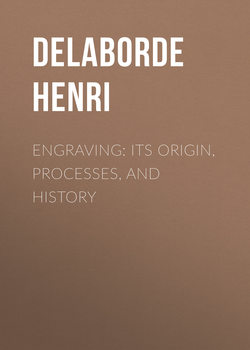Engraving: Its Origin, Processes, and History

Реклама. ООО «ЛитРес», ИНН: 7719571260.
Оглавление
Delaborde Henri. Engraving: Its Origin, Processes, and History
EDITORIAL NOTE
CHAPTER I. THE PROCESSES OF EARLY ENGRAVING. THE BEGINNINGS OF ENGRAVING IN RELIEF. XYLOGRAPHY AND PRINTING WITH MOVABLE TYPE
CHAPTER II. PLAYING CARDS. THE DOT MANNER
CHAPTER III. FIRST ATTEMPTS AT INTAGLIO ENGRAVING. THE NIELLI OF THE FLORENTINE GOLDSMITHS. PRINTS BY THE ITALIAN AND GERMAN PAINTER-ENGRAVERS OF THE FIFTEENTH CENTURY
CHAPTER IV. LINE ENGRAVING AND WOOD ENGRAVING IN GERMANY AND ITALY IN THE SIXTEENTH CENTURY
CHAPTER V. LINE ENGRAVING AND ETCHING IN THE LOW COUNTRIES, TO THE SECOND HALF OF THE SEVENTEENTH CENTURY
CHAPTER VI. THE BEGINNING OF LINE ENGRAVING AND ETCHING IN FRANCE AND ENGLAND. FIRST ATTEMPTS AT MEZZOTINT. A GLANCE AT ENGRAVING IN EUROPE BEFORE 1660
CHAPTER VII. FRENCH ENGRAVERS IN THE REIGN OF LOUIS XIV
CHAPTER VIII. ENGRAVING IN FRANCE AND IN OTHER EUROPEAN COUNTRIES IN THE EIGHTEENTH CENTURY. NEW PROCESSES: STIPPLE, CRAYON, COLOUR, AND AQUATINT
CHAPTER IX. ENGRAVING IN THE NINETEENTH CENTURY
A CHAPTER ON. English Engraving. By WILLIAM WALKER
CHRONOLOGICAL TABLE. OF THE MORE IMPORTANT ENGRAVERS BELONGING TO THE BRITISH SCHOOL OF ENGRAVING
Отрывок из книги
The nations of antiquity understood and practised engraving, that is to say, the art of representing things by incised outlines on metal, stone, or any other rigid substance. Setting aside even those relics of antiquity in bone or flint which still retain traces of figures drawn with a sharp-pointed tool, there may yet be found in the Bible and in Homer accounts of several works executed by the aid of similar methods; and the characters outlined on the precious stones adorning the breastplate of the high-priest Aaron, or the scenes represented on the armour of Achilles, might be quoted amongst the most ancient examples of the art of engraving. The Egyptians, Greeks, and Etruscans have left us specimens of goldsmith's work and fragments of all kinds, which, at any rate, attest the practice of engraving in their countries. Finally, every one is aware that metal seals and dies of engraved stone were in common use amongst the Romans.
Engraving, therefore, in the strict sense of the word, is no invention due to modern civilisation. But many centuries elapsed before man acquired the art of multiplying printed copies from a single original, to which art the name of engraving has been extended, so that nowadays the word signifies the operation of producing a print.
.....
The learned Zani had, in truth, his own reasons for taking Papillon at his word. Had the story tended to establish the pre-existence of engraving in Germany, he would probably have investigated the matter more closely, and with a less ready faith. But the glory of Italy was directly at issue, and Zani honest though he was, did not feel inclined to receive with coldness, still less to reject, testimony which, for lack of better, might console his national self-respect, and somewhat help to avenge what the Italians called "German vanity." Pride would have been a better word, for the pretensions of Germany with regard to wood engraving are based on more serious titles and far more explicit documents than the one discovered by Papillon, and recklessly passed on by Zani. Heinecken and the other German writers on the subject doubtless criticise in a slightly disdainful manner, and with some excess of patriotic feeling. For all that, they defend their opinions by documents, and not by mere traditions; and if all their examples are not quite evidently German, those which are not should in justice be attributed to Flanders, or to Holland, and by no means to Italy.
In this struggle of rival national claims the schools of the Low Countries are entitled to their share of glory. It is quite possible that their claims, so generally ignored towards the end of the last century, should in the present day be accounted the most valid of all; and that, in this obscure question of priority, the presumption may be in favour of the country which supplied an art closely connected with engraving with its first elements and its first examples. It would be unbecoming in every way to pretend to enter here on a detailed history of the origin of printing. The number of exhaustive works on the subject, the explanations of M. Léon de Laborde, M. Auguste Bernard, and more recently of M. Paeile, would render it a mere lesson in repetition or a too easy parade of borrowed learning. Anyhow, the discovery of printing with type is so intimately connected with the printing of engravings, and the practical methods in both are so much alike, that it is necessary to mention a few facts, and to compare a few dates. We shall therefore, under correction, reduce to the limits of a sketch the complete picture drawn by other hands.
.....